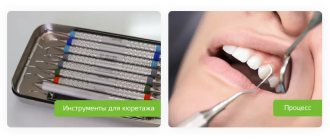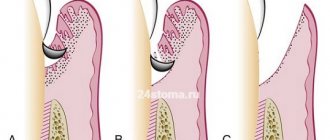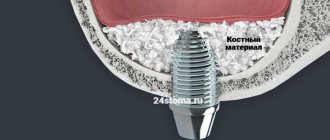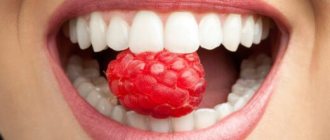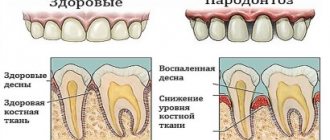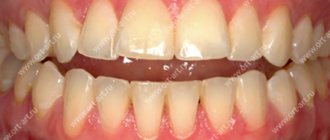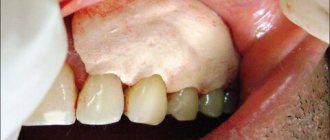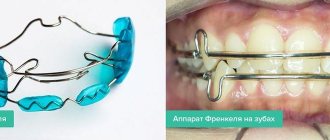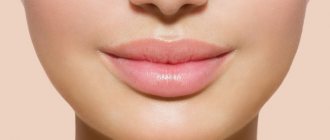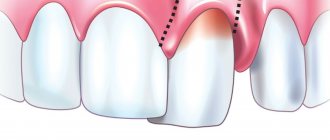09.11.2020 8216
If you look closely at the structure of the jaw, you will notice a groove separating the tooth and gum. Depending on the characteristics of the patient, it has a different structure and depth.
It is this groove that is called the periodontal pocket. The depth in a healthy person usually does not exceed 2 mm.
However, bacteria accumulate inside and severe inflammation gradually develops. Deepening begins, periodontitis or gingivitis develops.
The problem is that the dentist needs to remove the affected tissue to treat the patient. If this is not done, the process will only progress and the inflammation will affect larger and larger areas and begin to threaten the tooth.
The stripping process is called curettage.
About periodontal pockets and causes of inflammation
The problem does not appear by itself; there must be serious prerequisites for it.
The need for curettage is provoked by five potentially dangerous factors:
- Inflammation of the gums or periodontal tissues . Formed where soft tissue touches the tooth.
- Insufficient oral hygiene . If you brush your teeth incorrectly, food debris gets inside the groove. As they decompose, bacteria multiply.
- Serious dental plaque . Formed due to significant fossilization. Problems also begin for people who ignore the formation of tartar.
- Congenital anomalies . This leads to the pocket being deeper or having a non-standard structure. Bacteria will accumulate in it much more intensely.
- Diseases of the body . Patients with hormonal imbalances and digestive disorders are at risk. Their saliva composition changes, which can have a serious negative effect on the oral mucosa.
Curettage will be required if you have orthopedic structures installed and your metabolism is impaired.
Smokers and people who drink a lot of alcohol suffer from such problems - inflammatory processes are very common in them.
There are two types of periodontal pockets - false and true.
In the first case, the gum moves away greatly from the anatomical cell, and no damage to the deep tissues is observed.
In the second case, everything is more complicated, because periodontal tissue begins to collapse. This type of pocket can be either horizontal or vertical.
Hygienic care of periodontal pockets
Even if the depth of periodontal pockets is normal and does not exceed two millimeters, they require additional care. Unfortunately, a toothbrush is not suitable for this. Moreover, improper cleaning technique leads to additional contamination. If the movements of the bristles are directed only along a horizontal line or, what is even more dangerous, from top to bottom, then plaque and bacterial masses are “driven” under the gum. This can lead to the consequences that we discussed above. The movement of the bristles should be directed from the gums to the tops of the teeth, then additional contamination of the gum line and pockets does not occur.
Today, the best way to clean periodontal pockets is to use oral irrigators. A pressurized water jet is able to penetrate into the space between the gum and the tooth surface and effectively fight dirt and plaque there - the liquid under pressure washes away food particles and bacterial accumulations.
For this procedure, it is necessary to use special (periodontal) attachments, which are available for all models of Revyline irrigators. They have a soft rubber tip that is safe for your gums. Even if there is contact with inflamed gums, it will pass painlessly.
If there are signs of the development of periodontitis, it is recommended to use solutions based on therapeutic and prophylactic balms and rinses with natural plant extracts to wash orthodontic pockets as the working fluid of the irrigator.
Hydromassage of the gums using an irrigator gives very good results for strengthening the gums. The water jet has a squeezing-relaxing effect on soft tissues. As a result, blood supply improves and the supply of oxygen and nutrients to tissues is activated. Hydromassage is especially effective for smokers, since tobacco smoke constricts periodontal vessels and leads to tissue degeneration.
Signs of inflammation
As with many other diseases, the insidiousness of the situation is that the patient may not notice the problem for a long time. At the same time, it will constantly progress and get worse.
The disease can be noticed at an early stage if you regularly visit the dentist. The development of inflammation is indicated by 6 parameters:
- The gums change color - they turn red or darken.
- An unpleasant metallic taste appears in the mouth.
- A noticeable swelling begins to develop near the affected area.
- Severe bad breath.
- Loose teeth.
- Pain when pressing or eating food that requires chewing.
- Bleeding, which occurs, including during brushing your teeth.
Although it is not so easy to understand that there really is a problem at an early stage, it is possible.
And the sooner you can notice this, the sooner treatment can begin. This greatly affects the success of the final result.
The advantage of closed curettage
This procedure is quite quick and painless. The main advantage of closed curettage is the fact that even a regular dentist can perform it. Another advantage of this procedure is its low cost. Unfortunately, closed curettage has no other advantages. At the same time, it has many more shortcomings.
First of all, this operation can only be effective at a mild stage of periodontitis. If deep dental pockets are detected, closed curettage will be inappropriate. Another disadvantage is that this technique does not guarantee the prevention of the progression of periodontitis.
Features of curettage
Curettage becomes the last solution resorted to if alternative methods of correcting the situation fail.
This situation occurs when the pocket deepens to 4 mm.
At this stage, attempts to solve the problem with the use of drug treatment become futile.
When performing curettage, tissue is scraped out or deposits and affected areas are removed by other means.
If the procedure is performed by a dentist with extensive experience and a good level of training, no problems will arise. Moreover, the efficiency in this case will also be very high.
Recommendations after the procedure
Recommendations after curettage in dentistry are always individual. In some cases, for the first time you just need to give up solid food and brush your teeth with a hard brush. In others, you have to comply with more stringent requirements, see a dentist and remove stitches after the damage has healed. It is important to listen carefully to the doctor’s advice and try to follow all instructions as accurately as possible - then the curettage procedure will bring maximum benefit and periodontitis will not bother you for a long time.
Indications and contraindications
When a patient comes to the clinic with such a problem, they always take an x-ray.
It will show how severely the periodontal tissue is affected, what means are best to use for complex treatment, and whether surgical intervention is necessary.
There are 5 common indications:
- The appearance of severe loosening of teeth.
- Inflammation, accompanied by an increase in tissue temperature, redness, swelling, and pain.
- Large dental stones.
- Developing a deep true pocket.
- Exhaustion of conservative treatment options with antibiotics and other means.
The decision that curettage can be performed is made only after a comprehensive assessment of the situation and weighing of the data obtained. The list of contraindications includes the following:
- Pronounced fibrous changes developing inside the pocket.
- Severe thinning of gum tissue.
- The pocket depth is more than 6 mm.
- Tooth mobility of the third degree.
Most contraindications are temporary. It is not recommended to carry out the procedure if, for some reason, bacteria are actively multiplying in the mouth.
In such a situation, dental intervention simply will not have an effect and you will have to find the cause of the problem and eliminate it.
The structure of the periodontal pocket
A periodontal pocket is a space vacated by periodontal destruction. The inflammatory process disrupts the integrity of the dentogingival joints, and atrophy (resorption) of the alveolar bone begins. An area appears where there is no attachment of the gums to the surface of the tooth root.
Let us explain that the periodontium includes periodontal tissues:
- circular ligament of the tooth;
- cement covering the root;
- alveolar processes (the part that bears the teeth).
The bottom of the pocket is usually filled with granulation (connective) tissue, plaque and pus. There is a large number of destroyed leukocytes, which indicates a protracted inflammatory process. Food particles constantly fall into the hole.
The defect is clearly visible on an x-ray and appears as a dark area between the teeth. For diagnosis, the method of probing with hand instruments is also used.
Is it possible to perform curettage at the site of an extracted tooth?
Curettage of the socket of an extracted tooth - what is it? This process is similar to what is done when the tooth is still intact. After the tooth is removed, the dentist removes the affected tissue.
This process is carried out if suppuration begins at the site of the tooth, crumbs from hard tissue remain, alveolitis begins to form, or there are signs of necrosis of the walls.
The dentist performs a curettage, after which the wound is closed with a tampon. The process may often be required if, after tooth extraction, the patient behaved incorrectly and the wound did not heal as required.
Another common indication is the appearance of dry socket syndrome. It can lead to alveolitis and the fact that the area will not heal for a long time with all the ensuing dangerous consequences.
Typically, patients themselves are rarely able to determine that they have a problem. Therefore, it is important to be sure to come to the doctor on schedule in order to monitor how tissue restoration is progressing after surgery.
The process itself consists of 5 stages:
- The treatment site is anesthetized so that the patient does not feel anything. Both infiltration and conduction anesthesia are used.
- Washing the hole. All foreign matter is removed, including blood, food debris, and pus.
- Cleaning the tissue walls and the hole itself. This is a direct curettage that requires close attention from the dentist.
- Antiseptic treatment. This is necessary to prevent the spread of bacteria.
- Closing the wound. The doctor applies a bandage. This allows you to stimulate wound healing and reduce the likelihood of resumption of the inflammatory process.
Since the area is treated from all potential threats, the tissue begins to heal quite quickly, and the risk of alveolitis recedes.
What treatment is required for this clinical picture?
As for the treatment of diseases such as periodontitis and periodontal disease, an integrated approach is important to achieve stable remission. After carrying out all diagnostic procedures and making an accurate diagnosis, the doctor determines the tactics of further therapy. If necessary, prescribes appropriate procedures. For example, professional cleaning of plaque and deposits is required.
If there are already periodontal pockets, closed or open curettage is usually performed immediately. As part of complex therapy, special injections, applications with APRF membranes, a course of medications for oral administration, mouth rinses and topical application can be prescribed. If pus has already begun to ooze, antibiotics are prescribed. The following describes in more detail the main directions of complex treatment of such diseases.
Classic ultrasonic cleaning
To properly clean your pockets, you should definitely visit a dentist. You won’t be able to remove hardened deposits on your own at home. In dental clinics, this procedure involves the use of special ultrasonic devices for better and at the same time delicate removal of soft and hard deposits. Typically, ultrasonic cleaning is combined with sandblasting using an Air-Flow device, and the recesses are additionally washed using special syringes.
The photo shows ultrasonic cleaning
Gum curettage
For periodontitis, curettage is usually prescribed - this is a special procedure with which the doctor removes not only deposits, but also granulations, pus and food debris from the space between the mucous membrane and the tooth. Many people are interested in whether it is possible to cure the disease in this way, and here we need to clarify something. Unfortunately, it is impossible to completely cure pathologies such as periodontitis and periodontal disease. However, a comprehensive approach to treatment will help achieve stable remission and forget about disturbing symptoms for a long time, and prevent loosening and loss of teeth.
Closed curettage is performed without cutting or peeling off the mucosa. This procedure is usually prescribed if the depth of the defect does not exceed 3 mm. With a more serious lesion, the doctor will no longer be able to blindly clean the soft tissues from bacterial accumulations with sufficient quality, so in such cases the procedure is often performed using the open method.
The photo shows the closed curettage procedure
“I had a closed curettage done. The procedure was carried out under anesthesia, so everything went fine, I didn’t feel any pain. At first, the condition of the gums improved significantly, the bleeding, pain, and swelling went away. But honestly, after about 5-6 months, all the symptoms gradually returned. As a result, now it is necessary to perform open curettage, and this is a full-fledged operation. The doctor said that last time the pocket cleaners weren’t good enough, that’s why it’s like this.”
Timur, from correspondence on the forum www.32top.ru
Open curettage is often combined with augmentation of damaged jaw bone. For this, specialists, as a rule, use synthetic osteo-replacement chips. The procedure itself involves cutting the soft tissue and opening unhindered access to the root surface. After cleansing, it may be necessary to splint mobile teeth using fiberglass thread - according to indications.
At home, the patient will have to make oral baths for some time using antiseptic and anti-inflammatory solutions, apply appropriate topical products, and take prescribed medications, including antibiotics.
Flap operations
The effects of gum recession can be corrected with flap surgery. As part of the procedure, the doctor fills the missing area of the mucous membrane. To do this, he uses a scalpel or laser to make an incision on the mucous membrane, after which part of the tissue is removed or moved to a new location, that is, it is tightened, and then sutures are applied.
Gumplasty is one of the most effective ways to correct periodontal pockets
Drug therapy
After diagnosis and professional cleaning, the specialist will definitely give you detailed recommendations regarding home therapy. The doctor will tell you what is the best way to rinse your mouth, what toothbrushes and pastes to use, what medications to take. All this is prescribed purely individually, but there are several main vectors of drug therapy in periodontology, and here they are:
- antiseptic rinses - one of the most popular is Chlorhexidine. It and similar solutions have a pronounced antibacterial and anti-inflammatory effect,
- Antibiotics are prescribed during exacerbations of the pathological process, always if pus begins to be released. These are potent drugs that can only be taken as prescribed by a doctor.
- gels and ointments - help relieve swelling and soreness, reduce the intensity of inflammatory processes. Many of the local products have pronounced astringent properties, which promotes faster healing of affected tissues,
- multivitamin complexes - help strengthen the body and increase its protective functions, which also contributes to faster recovery.
The specialist moistens the tampon with the drug and places it in the periodontal pocket.
In the treatment of gums, it is very important to strictly follow the recommendations of a specialized specialist. You should not start taking any of the above medications without first visiting a doctor. Otherwise, you risk aggravating your condition and provoking unwanted reactions.
Open curettage technique
Treatment can be performed using various methods. And one of them is open curettage of periodontal pockets.
Dentists perform it to remove all deposits accumulated under the gums. This allows you to prevent the appearance of foci of inflammation, the development of much more serious problems, tooth loss or the need for tooth extraction.
For the procedure to be successful, it is usually accompanied by special restorative therapy.
The doctor prescribes the patient to take medications that reduce inflammatory activity in the body. In parallel, antibacterial treatment is performed.
The technique has proven itself well and allows for quick treatment of even a large number of teeth in one visit – up to seven in a row. At the same time, the use of local anesthesia makes the process much less traumatic for the patient.
It is carried out in several stages:
- Separation of the mucous membrane of the gums . It is important that it does not touch not only the bone, but also the alveolar process. This usually requires making a small, precise incision in the anatomical neck.
- Gum separation . This helps to access the bone pocket directly. The dentist will have a clear view of the affected area and will understand what is being dealt with.
- Curettage . The process uses a scaler. All solid deposits are removed. The tissue is scraped out using a curette – hence the name of the procedure.
- Antiseptic treatment . It is recommended to use special agents with a pronounced hemostatic effect - they prevent the accumulation of blood, the formation of clots and an environment for the proliferation of bacteria.
- Installation of synthetic bone . It is important that the treated fabrics are filled with something. The synthetic product helps reduce the periodontal pocket and prevents the previously eliminated problem from re-developing.
- Stitching . A suture is placed and a gum bandage is installed.
All requirements for the use of special means and antiseptic protection are observed very strictly, so regeneration takes place very quickly.
The standard period for suture removal is ten days. No further intervention will be required.
Despite the fact that the technology is well developed and shows excellent results in dental practice, doctors try to avoid its use.
This is a local surgical intervention that requires a recovery period and strict medical supervision.
Gum curettage is not painful
To prevent pain, procedures are performed under local anesthesia. For patients who want to get rid of not only pain, but also nervous experiences, we offer treatment “in their sleep” - with sedation. Ultra-short-acting sleeping pills immerse you in a state of shallow sleep. You don't hear or feel anything, absolute comfort!
Exit from the state without side effects of general anesthesia - no dizziness, nausea, clear consciousness. After 30-40 minutes, the drugs are completely eliminated from the body.
Closed operation
In addition to open surgery, closed curettage of periodontal pockets can also be used.
Typically, dentists recommend performing it if the pocket itself is shallow and only up to 3 mm .
One of the features of this technique is that the doctor practically does not see the condition of the tissue at the time of the intervention, and against the background of this, some part of the affected tissue remains inside.
When carrying out closed-type exposure, tissues are less injured, and by reducing the affected areas, it is possible to more effectively carry out conservative treatment using a special group of medications.
Most often, this method uses ultrasound. It perfectly removes deposits and is suitable for granulation. The impact itself does not require gum detachment.
By polishing and treating the cleaned areas, plaque no longer accumulates on them, and there is no risk that the problem will manifest itself again.
Rehabilitation after surgery
After gum curettage, special rehabilitation is not always required. Closed curettage procedures, especially those performed using ultrasound or laser methods, require virtually no special restrictions. Only in the first hours it is necessary to refuse to eat, and in the next 2-3 days - limit yourself to only soft (or semi-liquid) non-hot and not cold food. At first, teeth may react to hot and cold, but this sensitivity disappears later. After open curettage, it is necessary to carefully follow the doctor’s recommendations to prevent complications.
Alternative Methods
In addition to closed and open exposure, other types of operations can be used to clean out pockets. These include:
Laser curettage of periodontal pockets
This is one of the main techniques used in advanced dentistry today.
The advantage of the laser beam is that it heats up to high temperatures. In this case, the deposits are simply burned out and the vessels are sealed. This reduces the recovery period and eliminates the risk of re-deposition.
Another advantage is the complete elimination of the need for sutures. During the recovery period, the patient will not experience increased sensitivity due to food intake, and there will be significantly fewer restrictions.
The main thing is not to overheat or lift heavy objects on the first day after surgery. It is best to maintain a rest regime or go to bed so that the body can devote all its strength to regeneration.
Vacuum curettage
Belongs to the closed subtype. The process also uses special curettes, but they are connected to a device that can apply very low pressure.
The tissue is scraped out and immediately sucked out of the hole. The duration of the rehabilitation process is greatly reduced, and the likelihood of complications becomes significantly lower.
Chemical curettage
In this case, citric acid is actively used. It is created on the basis of various types of solutions and allows you to make deposits soft.
A balanced mixture of active substances is pumped into the pocket and actively cleanses it, gives a pronounced antiseptic effect and destroys most potentially dangerous bacteria.
Cryo method
The method is based on freezing tissue using special nitrogen-based compounds. This effectively removes deposits, kills bacteria, and significantly reduces the risk of complications.
This is one of the cowless ways to clean out a pocket.
Which method should I choose from those described?
Despite the fact that some seem to be much preferable to others, in practice everything is not so simple. The fact is that there are individual contraindications that do not allow some patients to use the most bloodless intervention options.
Only after a careful analysis of the patient’s current condition and an assessment of potential risks can one understand which method is best to use. The extensive experience of our doctors allows us to do this without errors.
Diagnostics
When a patient comes to the clinic, the dentist conducts the following examination:
- survey of patients, complaints;
- examination of the oral cavity using instruments;
- inspection of the quality of dental care;
- test for gingivitis;
- X-ray of the jaw;
- prescribing MRI or other hardware diagnostics;
- rheography.
The diagnosis is established when the following pathologies are identified:
- detection of symptomatic gingivitis;
- pronounced periodontal pockets;
- violation of the integrity of the cortical plate of the bone;
- osteoporosis - loss of bone tissue.
Gingivitis is characterized by redness of the gum tissue, sometimes it takes on a bluish tint. Periodontal pockets are checked for each tooth using a special probe. The degree of density/rarefaction of bone tissue makes it possible to distinguish periodontitis from periodontal disease. Periodontitis is characterized by a thinning of bone tissue density, while periodontal disease is characterized by compaction.
About the duration of the rehabilitation period
As with any surgical intervention, after curettage there is a recovery phase.
It is important to understand that the procedures themselves are safe and have already been well established in practice. But the patient will be required to follow a number of recommendations in order not to provoke the development of complications.
Among the important requirements at the rehabilitation stage are the following:
- Careful oral hygiene. During the first eight hours, it is better not to brush your teeth at all and not to disturb the operated area; it is not recommended to eat food, mouthwashes - anything that can cause irritation. After this period, you also need to be more careful with cleaning until the stitches are removed.
- If there is severe pain, you can only use medications recommended by your doctor. In most cases, simply applying something cold to the sore area helps.
- The diet is worth reconsidering. In particular, until the tooth heals and stops becoming loose, you should not chew on anything too hard.
- Avoid temperature changes. You should not go into the cold without protecting your cheeks or visit the sauna.
You will also need to comply with other doctor's requirements - use special rinses, change your standard toothbrush to a soft one.
What can you do at home?
First of all, you should definitely contact a periodontist. You need to understand that without the participation of a specialized specialist, it will not be possible to cure the disease in any case. Self-therapy at home is acceptable only as supportive therapy, but not as the main treatment. Otherwise, you will only be able to relieve acute symptoms, but the pathological process will continue to develop in a chronic form and ultimately lead to the complete destruction of the periodontal ligaments, loosening and loss of teeth.
After consultation with a specialist, you can use decoctions and infusions prepared from medicinal plants at home. They help speed up the healing process, stop further spread of inflammation, relieve pain, itching and burning. For example, for gums it is recommended to use tinctures of eucalyptus and calendula. One teaspoon of each should be dissolved in 200 ml of warm boiled water and used as a mouth rinse 2 times a day.
Herbal decoctions can be used at home
Propolis compresses have also proven themselves to be quite effective. A decoction of chamomile has a calming effect, and oak bark has pronounced astringent properties, which promotes faster restoration of damaged tissue. And another sure-fire remedy is a soda-salt solution. Mix a teaspoon of salt and soda in a glass of warm boiled water and use for rinsing. The solution helps relieve acute inflammation and relieve pain, significantly reduce redness and swelling.
Are there complications?
The procedure is safe and is carried out in strict compliance with all technology requirements.
But there are several potential problems that may arise as a result of personal characteristics of the body or non-compliance with requirements during the rehabilitation period.
These include the following:
- Sensitivity to food temperature . It occurs in almost everyone, but goes away over time. The maximum duration of hyperesthesia is up to two months. To cope with the problem, you can use special gels, ointments, toothpastes and rinses - the dentist will advise which ones.
- Swelling and hematoma . They may not go away for up to two weeks, but do not pose a serious danger.
- Problems in the functioning of the facial muscles . You should not be afraid of such a manifestation, because it will pass in about 10 days. Some patients complain of difficulty opening the mouth, but this also resolves in no more than 12 days, more often earlier.
- Increased tooth mobility . Observed for up to three weeks. For this reason, you need to pay attention again to your diet and remove foods that are too hard.
The patient's condition is constantly monitored by an experienced dentist, so that any serious complications can be avoided.
Consequences of gum pockets
When periodontal pockets form, the ligaments that hold the tooth in the alveolus (socket) are destroyed, the dental roots are exposed, and the crown loses its natural support. As a result of this pathological process, mobility of healthy teeth occurs and the bite is disturbed.
In this state, it is difficult for a person to chew even soft food. Ultimately, the interdental spaces increase more and more, and loose teeth begin to fall out one after another.
Therefore, if you notice that the gum has moved away from the tooth, do not delay a visit to the periodontist. Finding such a specialist is not difficult. Just use the search bar on our website.
When does a gum pocket appear?
Many people do not immediately understand that a pathological process, inflammation, is developing in the oral cavity. Therefore, the pathology becomes moderate or severe. Usually people after 30-40 years are prone to developing pockets. Since men smoke cigarettes more often, they are more prone to periodontitis. Adolescents are characterized by false pockets without destruction of bone tissue.
But in rare cases, periodontitis and periodontal disease with pathological pockets can form at a young age. This is an indication for a quick visit to a dentist and diagnostics. The earlier the disease is detected, the more effective the treatment will be.
